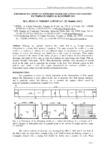Experimental study of depth-discharge equations and velocity patterns on vertical slot fishways

Ver/
Use este enlace para citar
http://hdl.handle.net/2183/809Coleccións
Metadatos
Mostrar o rexistro completo do ítemTítulo
Experimental study of depth-discharge equations and velocity patterns on vertical slot fishwaysData
2003Cita bibliográfica
Proceedings of the IAHR Congress, August 24-29, 2003, Thessaloniki, Greece, edited by J. Ganoullis and P. Prinos, p. 433-439
Resumo
Fishways are hydraulic structures that enable fish to go through transverse
obstructions to continue their upstream migrations. This paper presents the results of a scale
model of a vertical slot fishway. For two different slopes, the performance of two particular
designs of vertical slot fishways was studied for a wide range of discharges. Water depths
were measured in the almost all the surface of pools. A linear relation between dimensionless
discharge and depth of flow, and the same flow patterns for each design were found. With an
acoustic Doppler velocimeter (ADV), three-dimensional velocities were measured at several
levels in the entire pool to appreciate the structure of the flow. Two different regions in flow
patterns were found: a direct flow region characterized for maximum velocities; and a
recirculation region, defined by small velocities and horizontal eddies.
ISBN
960-243-597-6





